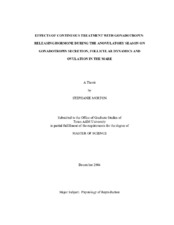| dc.description.abstract | Objectives were to determine if low-dose, continuous infusion of GnRH from
Fall to Spring, would prevent seasonal anovulation in mares. Twenty Quarter Horse
mares, ages 18 mo to 24 yrs, were stratified by age and body condition score and
assigned randomly to either a saline control (n = 9) or GnRH (n = 11) treatment group.
Treatments were instituted between September 23 and October 9, 2002. Gonadotropinreleasing
hormone was delivered in 0.9% physiological saline via Alzet osmotic
minipumps (Model 2004) placed sc at the base of the neck, with Silastic sham pumps
placed in control mares. Pumps were inserted on day 3 following ovulation or during the
follicular phase if ovulation had not occurred. Delivery rate of GnRH was 2.5 ug/h (60
ug/d) for the first 60 d, followed by 5.0 ug/h (120 ug/d) thereafter, with all pumps
replaced every 30 d. By December 1, all mares had become anovulatory and remained
anovulatory until February. Mean serum concentrations of LH were not affected by
treatment in anovulatory mares. In contrast, control mares that exhibited ovulatory
cycles after treatment onset had higher (P < 0.05) mean concentrations of LH during all
phases of the estrous cycle except diestrus. Mean serum concentrations of FSH were not
affected by treatment, but were lower (P < 0.05) from November though January relative
to all other months in anovulatory mares. Interovulatory intervals in mares that cycled
temporarily did not differ between groups. Ovulatory control mares had slightly larger
(P < 0.10) follicles overall than GnRH-treated mares; however, ovulatory follicle
diameters for control and GnRH-treated mares did not differ. Ovulatory control mares
had higher (P < 0.10) mean concentrations of progesterone during metestrus and late
diestrus. In a subgroup of control (n =5) and GnRH-treated (n = 5) mares, total
releasable pools of LH in response to 1 mg GnRH did not differ between groups.
Ovulation resumed in 3 control and 3 GnRH-treated mares by March 30. Results
indicate that continuous infusion of native GnRH at the doses employed herein is not
sufficient to maintain ovulatory cycles during the anovulatory season. | en |


